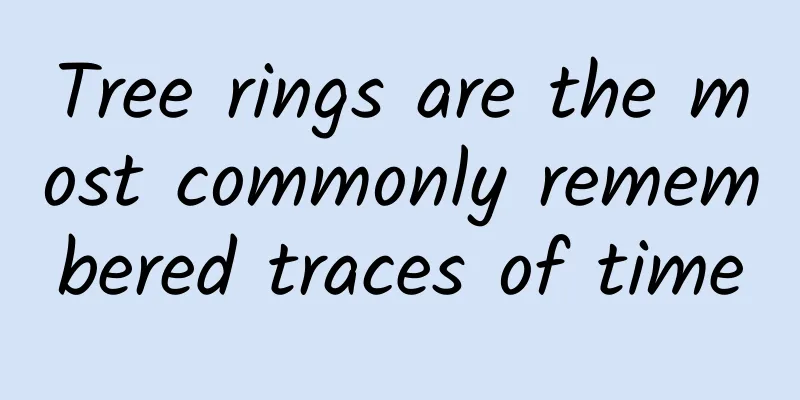Tree rings are the most commonly remembered traces of time

|
Humans are the longest-lived mammals, but we still feel that life is short. Everything is drifting on the long river of time, but the length of the journey can range from being born in a morning to dying in a night, to living forever. Tree rings are the most commonly remembered traces of time. In temperate forests, trees grow rapidly in the spring when there is plenty of rain, producing spring wood with loose and shallow spacing; they grow slowly in the bleak autumn, producing autumn wood with a hard and dense texture. As spring goes and autumn comes, spring wood and autumn wood alternate, forming layers of annual rings. But not all trees grow in the same rhythm of one growth ring per year. Tropical trees generally do not have growth rings because they grow at a constant speed throughout the year. Subtropical trees such as Masson pine and yew have two growing seasons a year, so they grow two layers of growth rings a year. Citrus trees even have three growth rings a year. If there are abnormal climate years such as summer drought, some trees may also have missing growth rings or "pseudo growth rings". In 2006, British researchers fished out an Arctic clam (Arctica islandica) in Iceland that was 507 years old. As the shell grows, it leaves a circle of lines every year, just like the annual rings of a tree. The researchers named the Arctic clam "Ming", indicating that it was born in the Ming Dynasty of ancient China. Arctic clams are living ocean history books. The oxygen isotopes deposited in the shells can reflect the temperature of the seawater at that time, and the "annual rings" indicate the period of shell growth. By studying clam shells of different ages, we can understand the impact of the greenhouse effect on seawater at different periods in history. An Arctic clam with its cuticle peeled off | Manfred Heyde / wikimedia Zhuangzi said: "Small knowledge is not as good as great knowledge, and small years are not as good as big years." Cicadas do not know that there are four seasons in a year, while big trees consider eight thousand years as one autumn. Although cicadas were ridiculed by Zhuangzi, some short-lived creatures have an amazing concept of time. The silverside (Leuresthes tenuis) in the southern California waters follows a precise activity cycle during the breeding season, laying eggs every fourteen days. The special thing about the silverside is that it lays its eggs on the beach, so that it can avoid predators in the sea. They lay eggs on the days of the new moon and the full moon, when the moon has the greatest impact on the tide. The sea water is the highest at high tide, and when the silverside rushes to the beach, the tide will push them as far as possible. In the half month after spawning, because the tide is not that strong, the eggs can develop slowly on the beach until the tide rises again, when the little fish hatch and ride the tide back to the sea. Female fish that bury themselves to lay eggs | Loren Rodgers The life span of a single coral polyp may be short, but the calcareous skeletons they leave behind can continue to "build" for thousands of years. Although age cannot be equated with wisdom, the traces of time left on life can always give us some valuable inspiration. Corals deposit a very thin layer of calcium carbonate every day, leaving a ring pattern, and the growth rate of corals varies in different seasons of the year. Therefore, corals are both calendars and almanacs. The amount of calcium layer can tell us the date, and the thickness of the calcium layer can help us identify the year. Coral reefs, and the skeletons of different corals | Toby Hudson & Jon Zander & Narrissa Spies & James St. John / wikimedia; piqsels The calendar on coral can also reveal some unexpected information. The Silurian coral fossils from more than 400 million years ago have 420 lines per year, which means that the Earth at that time had 420 days per year. From this, we know that the Earth's rotation speed has been slowing down due to the attraction of the moon. Those tiny passers-by have thus recorded the greatest and longest-lasting changing force in the universe - gravity. If we look at the entire river of time, human beings' years and years are just like the work of coral polyps, leaving only a thin line of sediment. Can the marks we leave behind be connected to the vast universe? This article comes from Guokr, welcome to forward If you need to reprint, please contact [email protected] |
<<: She joined the Party at the age of 102 and died at the age of 103. Her story is admirable!
>>: Smart eating in winter - are the nuts you eat carbohydrates or fats?
Recommend
With a budget of 200,000 yuan, for a pure electric SUV, which one would you choose, Zhiji LS6 or Zeekr 7X?
On September 20, Geely's pure electric brand ...
Ledgers, Hounds, and Boars
Wang Youqin lost confidence in farming after thre...
Mother's Day copywriting is here, here is a secret to seduce your mom!
This Sunday, May 13th is Mother's Day . In ad...
Apple Store apps are frequently removed from the shelves and subtitles are rejected. How can we ensure accurate and safe promotion?
The recent frequent actions of the Apple Store ha...
Counterpoint: Global sales of pure electric passenger vehicles increased by 29% year-on-year in Q3 2023
In the pure electric vehicle market, Tesla is the...
Guangdong bans electric vehicles
The "Guangzhou Non-Motor Vehicle and Motorcy...
A pharmacy in Hubei was fined 40,000 yuan for selling masks at 0.6 cents per piece. It was suspected of raising the price of masks!
Beijing News Express According to the official We...
How to better cultivate users' ability and habits to pay?
Today we are going to talk about a common and rel...
After the 80 million patent case, Huawei chose to fight back against Samsung's exclusion
Recently, a well-known big data organization rele...
How about Wen Biquan: What are the techniques to solve the problem of website inclusion?
As an SEO optimizer, we are really worried when o...
The human brain's "speed" is slower than expected; new research suggests that dark energy may not exist | Technology Weekly
Compiled by Zhou Shuyi and Pingsheng Chimpanzees ...
Japan has developed a physical mosquito repellent that can stop mosquitoes from flying within seconds with just one spray. How does this new technology work?
According to media reports, new research by Japan...
Sending 14 cabinets to the sky? What were they thinking?
The Shenzhou-15 crew, including Fei Junlong, Zhan...
WeChat Mini Program Retention Rate, How to Improve the Mini Program Retention Rate?
Retention is when a user performs a desired actio...
Why did Toutiao become the target of BAT's encirclement again after escaping from the trap?
The Chinese Internet industry has been dominated ...









